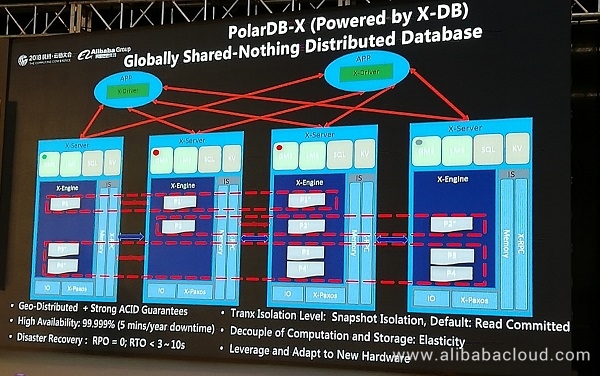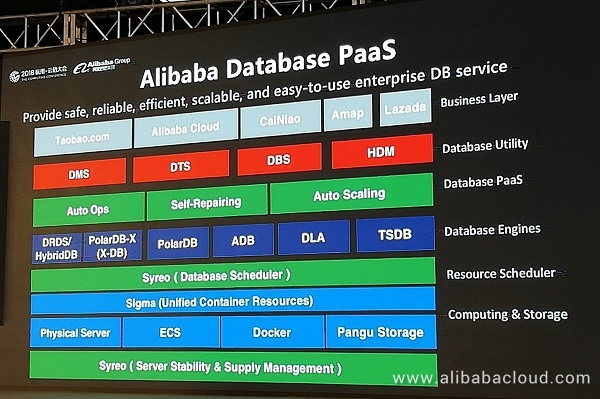By Wei Tong
"Software dies, but ideas won't die if they are shared"
At the Database Developer Ecosystem Summit of The Computing Conference 2018, Alibaba Cloud shared its vision and ambition towards the development of a fully open source database ecosystem. Titled "Hyperconnectivity and Openness in the Digital Age", this session featured many well-known speakers including Michael Widenius, Founder of MySQL and MariaDB, as well as Bruce Momjian, Co-Founder of PostgreSQL Global Development Group.
Perhaps the highlight of this session was the official announcement of the Alibaba Cloud-MariaDB strategic partnership, which featured Michael Widenius of MySQL/MariaDB and Cao Wei, General Manager of Alibaba Cloud Database. With this partnership, the two companies will now offer enterprises direct support for MariaDB database deployments in the Alibaba Cloud and provide access to MariaDB's most secure enterprise solution for transactional workloads. Alibaba Cloud customers will be able to enjoy the full benefits of MariaDB enterprise for their mission critical workloads with immediate access to essential patches, bug fixes and professional database support. Alibaba Cloud, winner of the MySQL Community Award, proves its dedication towards the open source database community through this partnership.
Li Feifei, Head of Alibaba Database and Storage, introduced the powerful PolarDB and the upcoming PolarDB-X. PolarDB is Alibaba's next-generation relational database based on the cloud computing framework. PolarDB was created to tackle the most difficult challenges in database management, including hybrid row/columnar storage, hybrid workloads, high availability, and scalability. PolarDB-X, a database engine based on the shared-nothing architecture, serves as an extension to PolarDB and is set to be launched in 2019.

Li credits PolarDB's success to the vast ecosystem of Alibaba Group. PolarDB successfully supported the 2017 Alibaba Singles' Day Online Shopping Festival, handling over:
As a key element in Alibaba's database platform-as-a-service (PaaS), PolarDB helps Alibaba support enterprise-level applications and solutions including Alibaba Cloud's very own ET Brain solution. Li also predicts that by 2020, 85% of database instances within Alibaba group will be self-driven.

To learn more about Alibaba Cloud PolarDB, check out PolarDB: Deep Dive on Alibaba Cloud's Next-Generation Database.
Bruce Momjian, Co-Founder of PostgreSQL Global Development Group, talked about the adoption of open source relational database management systems (RDBMS) by enterprises. He stated that in the past, the software industry heavily favored the use of proprietary software due to the number of features and services provided. But as time passed, enterprises were affected by the limited lifetime of proprietary software. He summarized the lifecycle of proprietary software as follows:
Unlike proprietary software, open source software goes through a more sustainable lifecycle. Open source software has also a lower barrier to entry for enterprises due to its low cost. Although cost is the first thing most enterprises consider when adopting open source, oftentimes they continue using open source by discovering other advantages of open source. Because open source development is not limited to profitability, innovation is continual. Additionally, open source innovation comes from multiple directions simultaneously; it is not limited by enterprises or geographical location. Bruce summarized the importance of open source with a meaningful quote, "Software dies, but ideas won't die if they are shared."
However, there is one limitation to open source software – enterprise-level support. The reason why enterprises still use proprietary software is because of the amount of resources and support available for enterprises. For open source software such as PostgreSQL, cooperation with other enterprises is vital for producing a reliable last-mile service.
Ed Boyajian, President and CEO of EnterpriseDB, talked about the importance of such cooperation and announced the Alibaba and EnterpriseDB Postgres partnership. Founded in 2004, EnterpriseDB is a world leader in open source based PostgreSQL software and services. Ed stated that although proprietary software can provide enterprises with a plethora of features, most enterprises only use 20% of these features. Because of this, and because of the flexibility provided by open source, he predicted that by 2019, the popularity of open source licenses will exceed commercial licenses.
With the rise of artificial intelligence, Internet of Things (IoT), and big data, we have seen a rapid growth in not only the amount of data but also the types of data stored. Most enterprises prefer storing these types of data in its raw format, which gives rise to NoSQL databases. In fact, NoSQL databases have become the preferred choice when running big data analytics or machine learning systems. Ye Xiang, Senior Staff Engineer of Alibaba Cloud, discussed how Alibaba Cloud enables enterprises to meet the needs of big data with its ApsaraDB NoSQL Open Source database, which supports both Redis and MongoDB.
For Shen Chunhui, Senior Staff Engineer of Alibaba Cloud, the real challenge for big data lies in the data collection, storage, and analysis for distributed systems. Due to the dynamics brought about by different applications, there needs to be a system that is capable of combining data from all types of sources for convenient access. Alibaba Cloud ApsaraDB HBase is capable of doing this by introducing independent modules, making it easy to upscale the database.
In IoT systems, data transactions happen at an astronomical rate. To cope with this issue, traditional database standard operating environment (SOE) introduces many layers for caching. However, this approach is complex, hard to deploy, expensive, and most importantly – not scalable. Dr. Srini V. Srinivasan, Founder of Aerospike, introduced a different approach to designing high performance databases for real-time applications. He introduced the hybrid memory database, an effective approach that merges the cache and database layers into a single layer.
For the latest news and video replays of The Computing Conference 2018, visit www.alibabacloud.com/the-computing-conference-2018.
How to Install and Configure the Windows Server Failover Clustering on an ECS Instance

2,605 posts | 747 followers
FollowAlibaba Clouder - October 15, 2018
Alibaba Clouder - October 17, 2018
Alibaba Clouder - September 28, 2018
Alibaba Cloud Community - March 15, 2024
Alibaba BlockChain Service Team - August 27, 2018
Alipay Technology - August 21, 2019

2,605 posts | 747 followers
Follow PolarDB for PostgreSQL
PolarDB for PostgreSQL
Alibaba Cloud PolarDB for PostgreSQL is an in-house relational database service 100% compatible with PostgreSQL and highly compatible with the Oracle syntax.
Learn More PolarDB for Xscale
PolarDB for Xscale
Alibaba Cloud PolarDB for Xscale (PolarDB-X) is a cloud-native high-performance distributed database service independently developed by Alibaba Cloud.
Learn More Big Data Consulting Services for Retail Solution
Big Data Consulting Services for Retail Solution
Alibaba Cloud experts provide retailers with a lightweight and customized big data consulting service to help you assess your big data maturity and plan your big data journey.
Learn More Big Data Consulting for Data Technology Solution
Big Data Consulting for Data Technology Solution
Alibaba Cloud provides big data consulting services to help enterprises leverage advanced data technology.
Learn MoreMore Posts by Alibaba Clouder